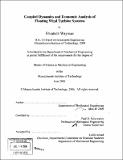| dc.contributor.advisor | Paul D. Sclavounos. | en_US |
| dc.contributor.author | Wayman, E. N. (Elizabeth N.) | en_US |
| dc.contributor.other | Massachusetts Institute of Technology. Dept. of Mechanical Engineering. | en_US |
| dc.date.accessioned | 2007-01-10T16:56:13Z | |
| dc.date.available | 2007-01-10T16:56:13Z | |
| dc.date.copyright | 2006 | en_US |
| dc.date.issued | 2006 | en_US |
| dc.identifier.uri | http://hdl.handle.net/1721.1/35650 | |
| dc.description | Thesis (S.M.)--Massachusetts Institute of Technology, Dept. of Mechanical Engineering, 2006. | en_US |
| dc.description | Includes bibliographical references (p. 145-146). | en_US |
| dc.description.abstract | Against the backdrop of rising oil prices and increasing uncertainty in the future of energy and the health of the environment, wind energy is distinguished as a leading technology that is both technologically and economically viable for large-scale non-petroleum and non-polluting energy generation. The deployment of wind energy technology on floating platforms in deep water offshore environments has emerged as a forward-thinking application of this technology. This thesis takes some early steps toward the development of innovative and cost-effective floating platforms to support a 5-MW wind turbine for deployment in water depths of 30 - 300 meters. A tool for performing a coupled structural, hydrodynamic, and aerodynamic analysis of floating wind turbine systems in the frequency domain was developed and is presented. This analysis tool includes the effects of the gyroscopic loads of the wind turbine rotor on the tower and floater, the aerodynamic damping introduced by the wind turbine rotor, the hydrodynamic added mass and damping introduced by wave-body interactions, and the hydrodynamic forces caused by wave excitation. | en_US |
| dc.description.abstract | (cont.) This analysis tool was applied to several structures representing excerpts of the design space of structures capable of supporting large wind turbines. The structures were evaluated on their dynamic performance in several environmental conditions and on their installed cost. An economic analysis was also carried out to determine the cost of the floating platform for the wind turbine per kWh of electricity generated. | en_US |
| dc.description.statementofresponsibility | by Elizabeth Wayman. | en_US |
| dc.format.extent | 146 p. | en_US |
| dc.format.extent | 6025494 bytes | |
| dc.format.extent | 6031602 bytes | |
| dc.format.mimetype | application/pdf | |
| dc.format.mimetype | application/pdf | |
| dc.language.iso | eng | en_US |
| dc.publisher | Massachusetts Institute of Technology | en_US |
| dc.rights | M.I.T. theses are protected by copyright. They may be viewed from this source for any purpose, but reproduction or distribution in any format is prohibited without written permission. See provided URL for inquiries about permission. | en_US |
| dc.rights.uri | http://dspace.mit.edu/handle/1721.1/7582 | |
| dc.subject | Mechanical Engineering. | en_US |
| dc.title | Coupled dynamics and economic analysis of floating wind turbine systems | en_US |
| dc.type | Thesis | en_US |
| dc.description.degree | S.M. | en_US |
| dc.contributor.department | Massachusetts Institute of Technology. Department of Mechanical Engineering | |
| dc.identifier.oclc | 76761300 | en_US |
